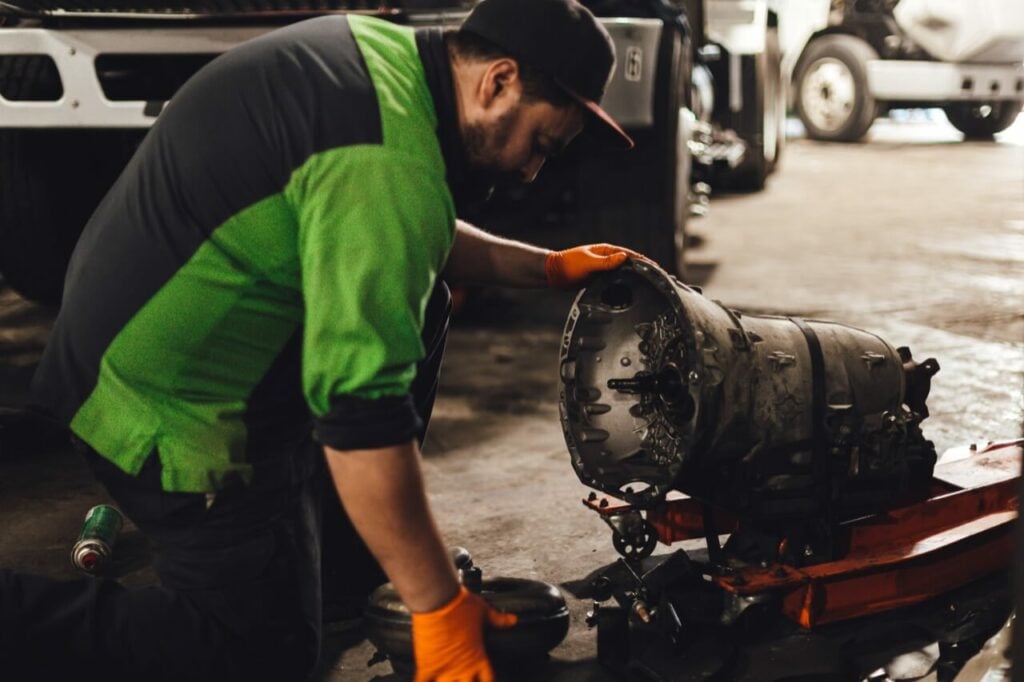A heavy-duty truck’s transmission works to help you control your speed as well as maintain efficiency. You’ll need to pay attention to the fluid level in the transmission; if it’s low, this can lead to a complete failure of the engine and drivetrain.
The clutches are used to connect the transmission to the engine, and they are usually disc-shaped plates that are pressed against one another with springs behind them. You’ll need to replace your transmission or clutches if they hit each other hard enough to cause damage, which can happen if your truck’s clutch is worn out.

There are certain telltale signs that something is wrong with your transmission or clutches. For example, if your truck changes gears on its own or you feel a shudder when the transmission shifts, this could indicate that there’s something wrong with your clutches. You’ll also know you have faulty clutches if they make loud noises every time you press down the gas pedal.
Transmission & Clutch Solutions
Generally speaking, there are two main solutions to transmission problems. The first would be to flush out the old fluid and replace it with new, synthetic antifreeze. This will help your engine lubricate your transmission properly and also ensure that all moving parts work as smoothly as they should.
If that doesn’t work, then it’s time to replace the transmission fluid lines, fittings, and filters. This is a harder job because you have to take apart your truck engine, so a professional mechanic can only tackle it.
Another option is to replace your transmission entirely if it fails or you notice problems like leaking fluids or a lack of pressure when applying the gas pedal. This will be more costly than flushing out the old fluid, but it also comes with an extended warranty and is easier to claim on your insurance policy over time.
If the problem is with the clutch, you’ll need to replace it or have it repaired. Conversely, if your transmission has problems, but your clutches are still intact, the problem is likely caused by a lack of fluid in the transmission pan.
Frequently Asked Questions
Common signs of a transmission issue include difficulty or delays when shifting gears, slipping out of gear while driving, or hearing unusual grinding or whining sounds. You might also notice a burning smell, which can indicate overheating fluid, or see visible leaks of red or brown transmission fluid under your truck. If the “Check Engine” or a specific transmission warning light illuminates on your dashboard, it is crucial to seek a professional diagnosis immediately.
Repairing or replacing your truck’s transmission depends on the extent of the damage. Minor issues, such as replacing a solenoid or fixing a leak, can often be resolved with a targeted repair. However, in cases of severe internal damage or widespread wear, a complete replacement or remanufactured transmission may be a more reliable and cost-effective long-term solution. Our certified technicians can perform a thorough diagnostic to provide a clear recommendation based on your truck’s condition and your operational needs.
A failing clutch will present several distinct warning signs. You may notice the clutch pedal feels soft, spongy, or vibrates when you press it. A common indicator is a “slipping” clutch, where the engine RPMs increase but the truck doesn’t accelerate accordingly. Other symptoms include difficulty shifting gears, especially into first or reverse, and unusual chattering or grinding noises when you engage or disengage the clutch.
Transmission fluid change intervals vary depending on the manufacturer’s recommendations, the type of transmission (manual or automatic), and your truck’s specific application. For heavy-duty trucks in severe service, such as those with heavy loads or frequent stop-and-go driving, fluid changes are typically recommended more frequently. As a general guideline, it is wise to have the fluid and filter changed according to your owner’s manual service schedule to ensure proper lubrication, prevent overheating, and extend the life of your transmission.
Schedule Semi Truck Service at Inland Kenworth
To schedule service, fill out the form below or find the nearest location to you and get in touch.

